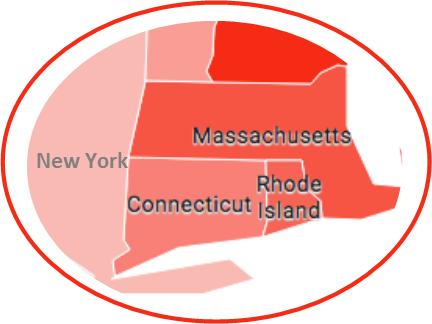Hurricanes v. Whalers: Words and Numbers Tell Different Stories
/In the midst of the war of words between unrelenting fans of the former Hartford Whalers (joined by Governor Malloy) and the Raleigh News & Observer, which has aimed a cease and desist order at Hartford, it may be worthwhile to delve into the data. It prove to be a distinction without a difference, however.
Gov. Malloy’s February 8 letter to Thomas Dundon, a Dallas businessman and new owner of the Carolina Hurricanes, urged that the team return to the Nutmeg State for a regular season game at Rentschler Field or the XL Center so the team could be “embraced by a grateful fan base.” Doing so, Malloy pointed out, “would make clear that Hartford is a far more viable long-term home for the team than Raleigh.”
When asked days ago by The Sporting News about the 'Canes future in Raleigh, Dundon said: “As long as I’m involved, this is where we’re going to be. One of the best things about this is the people. They’re just nice people here. They care. There’s no reason to be anywhere else.”
In an editorial, the Raleigh newspaper added that if a game were to be played in Hartford, it would be preseason, not regular season, and only because it would be “a chance to hoover some money out of the pockets of long-suffering Whalers fans desperate to see NHL hockey again… But that’s not going to happen.”
Last season, the Hurricanes had the league’s lowest attendance, averaging 11,776 per home game. It was their second consecutive season at the bottom of the league in attendance. In the 2015-16 season, average attendance was 12,203. Midway through this season, after 27 home games, the Hurricanes are averaging 13,039, 29th out of 31 teams in the league.
In the Whalers’ final season in Hartford, 1996-97, attendance at the Hartford Civic Center had grown to 87 percent of capacity, with an average attendance of 13,680 per game. Published reports suggest that the average attendance was, in reality, higher than 14,000 per game by 1996-97, but Whalers ownership did not count the skyboxes and coliseum club seating because the revenue streams went to the state, rather than the team.
Attendance increased for four consecutive years before management moved the team from Hartford. (To 10,407 in 1993-94, 11,835 in 1994-95, 11,983 in 1995-96 and 13,680 in 1996-97.) During the team’s tenure in Hartford, average attendance exceeded 14,000 twice – in 1987-88 and 1986-87, when the team ranked 13th in the league in attendance in both seasons.
During the 15 years prior to the past two seasons at the bottom, Carolina has been among the league’s bottom-third in average attendance eight times, and the bottom-half every season but one.
The Sporting News has reported that Dundon purchased a 61 percent stake in the franchise last month, with Peter Karmanos, who relocated the Whalers to North Carolina in 1997, retaining a 39 percent minority stake. Dundon reportedly has an option to purchase the remainder in three years. He is a New York native, and lived in New Jersey and Houston before Dallas.
The arena's lease in Raleigh expires in 2024. The team's current playoff drought is the longest of any team in the NHL - nearly a decade.
In the interview, Dundon pointed out “We have a really passionate, loyal season ticket base. The number is just smaller than you’d like it to be, but you have one. Every year that’ll grow. So the only challenge is just the amount of people that you have to touch. It’s inevitable that we’re going to touch them all and we’re going to get them.”



 Even in advance of the merger plan, the Board of Regents has been extending lower tuition offers in every direction, reaching out to students in Massachusetts, Rhode Island, New York and even New Jersey, making offers that the Regents hope will be tough to refuse.
Even in advance of the merger plan, the Board of Regents has been extending lower tuition offers in every direction, reaching out to students in Massachusetts, Rhode Island, New York and even New Jersey, making offers that the Regents hope will be tough to refuse.



 According to “The State of Languages in the U.S.: A Statistical Portrait,” Connecticut was one of seven states, along with New Jersey, Pennsylvania, Maryland, Vermont, New Hampshire and Wisconsin, where more than 30 percent of K-12 students were enrolled in language. As of 2014, only twelve states had more than one in four elementary- and secondary-school students studying languages other than English.
According to “The State of Languages in the U.S.: A Statistical Portrait,” Connecticut was one of seven states, along with New Jersey, Pennsylvania, Maryland, Vermont, New Hampshire and Wisconsin, where more than 30 percent of K-12 students were enrolled in language. As of 2014, only twelve states had more than one in four elementary- and secondary-school students studying languages other than English.
 Carrie Saxon Perry was the first black woman to be elected mayor of a major New England city – in 1987. Milner was the first black mayor in all of New England, elected in Hartford in 1981. There hasn’t been a black mayor leading the Capitol City since Saxon-Perry’s term ended in 1993.
Carrie Saxon Perry was the first black woman to be elected mayor of a major New England city – in 1987. Milner was the first black mayor in all of New England, elected in Hartford in 1981. There hasn’t been a black mayor leading the Capitol City since Saxon-Perry’s term ended in 1993. Across the country, Jacksonville, Memphis, Philadelphia and San Antonia had black mayors until recently, Governing reported. Detroit elected its first white mayor in 40 years in 2013. The nation’s largest cities – New York, Los Angeles and Chicago – have each has one black mayor, years ago. Atlanta elected a black female as mayor in a run-off election, winning with just over 50 percent of the vote.
Across the country, Jacksonville, Memphis, Philadelphia and San Antonia had black mayors until recently, Governing reported. Detroit elected its first white mayor in 40 years in 2013. The nation’s largest cities – New York, Los Angeles and Chicago – have each has one black mayor, years ago. Atlanta elected a black female as mayor in a run-off election, winning with just over 50 percent of the vote.


 The consolidation plan was subsequently approved by the Board of Regents of CSCU in December, with only one member of the Board abstaining and others unanimously supporting the plan, developed to save money across the system by eliminating staff positions, many said to be duplicative, that would not adversely impact students. Student and faculty groups at the campuses have raised questions about the ultimate effectiveness of the plan, or have opposed it outright.
The consolidation plan was subsequently approved by the Board of Regents of CSCU in December, with only one member of the Board abstaining and others unanimously supporting the plan, developed to save money across the system by eliminating staff positions, many said to be duplicative, that would not adversely impact students. Student and faculty groups at the campuses have raised questions about the ultimate effectiveness of the plan, or have opposed it outright.

 Compared with other states, the percentage of women in Connecticut’s legislature has been dropping, in real numbers and as compared with other states. In 2015, the percentage was 28.3 percent; in 2013 it was 29.4 percent; in 2011 Connecticut’s legislature was 29.9 percent women. In 2009, Connecticut’s legislature included 31.6 percent women, which was the seventh highest in the nation.
Compared with other states, the percentage of women in Connecticut’s legislature has been dropping, in real numbers and as compared with other states. In 2015, the percentage was 28.3 percent; in 2013 it was 29.4 percent; in 2011 Connecticut’s legislature was 29.9 percent women. In 2009, Connecticut’s legislature included 31.6 percent women, which was the seventh highest in the nation.
 The model reflects that determinants of health directly influence health outcomes. A health outcomes category and four categories of health determinants are included in the model: behaviors, community & environment, policy and clinical care.
The model reflects that determinants of health directly influence health outcomes. A health outcomes category and four categories of health determinants are included in the model: behaviors, community & environment, policy and clinical care.

 The article points out that “the connection between climate change and hurricanes has become hard for anyone to ignore.”
The article points out that “the connection between climate change and hurricanes has become hard for anyone to ignore.”




























